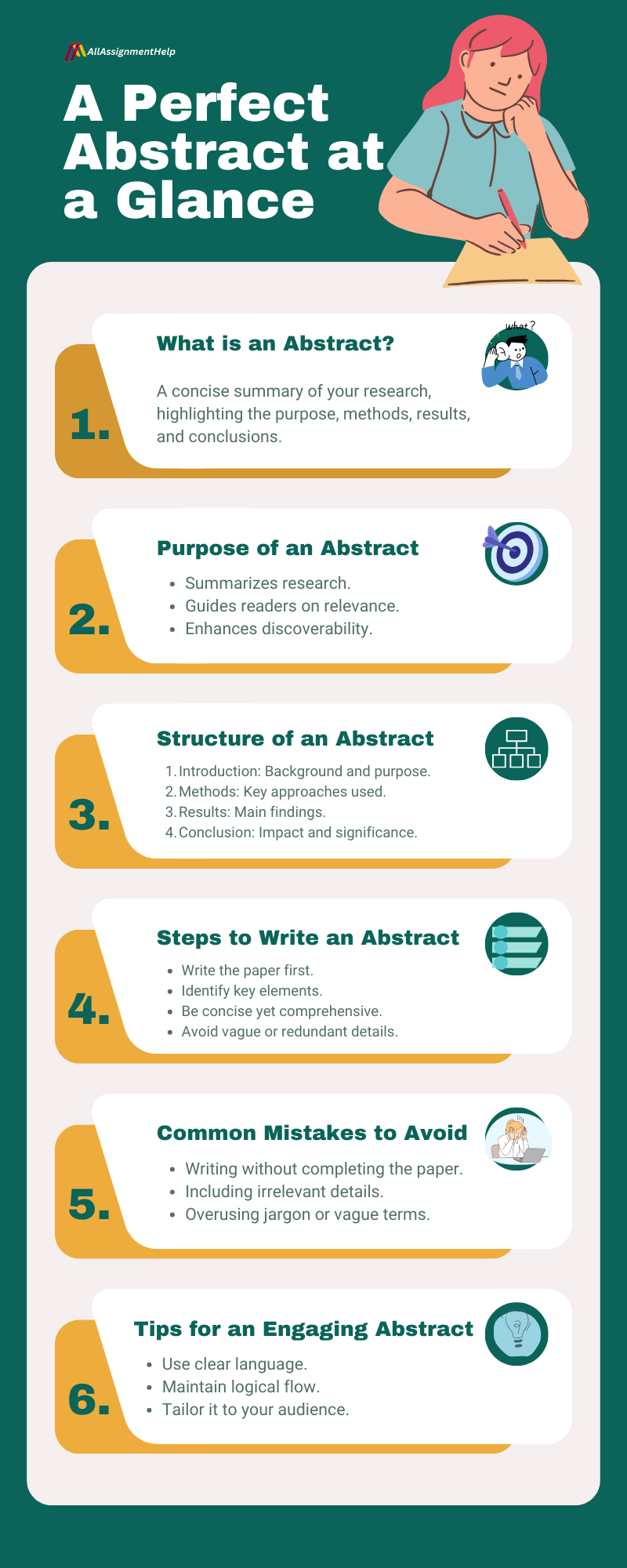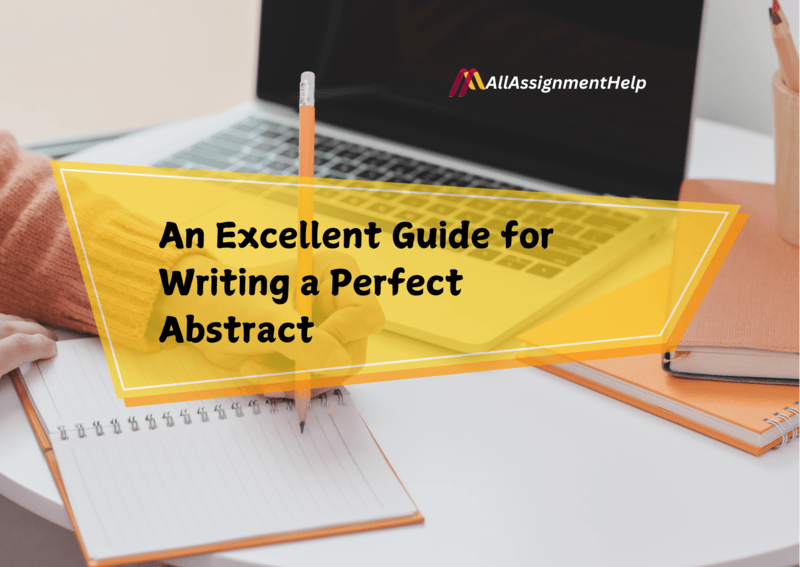Table of Contents
One of the things that determines whether a reader will read your research is the abstract, which serves as the introduction. It gives a brief synopsis of your objectives, approach, findings, and commentary, effectively and concisely condensing your entire work. Moreover, a perfect abstract is a work of art, whether you are creating one for a journal article, dissertation, or academic paper.
Everything you need to know for writing a perfect abstract will be covered in this blog by All Assignment Help, starting with the definition and purpose of an abstract, its structure, and, lastly, typical errors to avoid. By the end of the blog, you will have the tools necessary to create an abstract that enthrals your audience and is both educational and captivating.
What is an Abstract?
An abstract is a short summary of an article, thesis, review, conference proceeding, or any in-depth analysis of a particular subject or discipline. It summarizes the most important parts of the work; the intent of the study, methodology, results, and discussion, without readers having to read the whole paper. They provide a roadmap guiding researchers, students, and professionals to understand if the work falls under their interests or not. There are two primary categories of abstracts:
- Informative abstract: These types of abstracts offer very specific information about research, including results and conclusions.
- Descriptive abstracts: High-level topics overview without mention of the results.
These differences are crucial to meet the goal of writing a perfect abstract.
Also read: How to Write a Research Journal?
The Purpose of an Abstract
The abstract is a short summary explaining what the paper entails, informing the audience what to expect and if it is worth reading. It serves as an independent summary of the essential objectives, methods, results, and conclusions within a concise report. Abstracts perform several critical functions, such as:
- Guidance for readers: It assists potential readers in deciding if the full documents are relevant to them.
- Search and Indexing: Improves discoverability in both academic databases and search engines.
- Clear and concise: Provides a clear and concise description of the work for talks, proposals, and submissions.
Fulfilling these functions, abstracts help spread information rapidly and easily in academic and professional waves.
Also read: Easiest Ways to Learn a Foreign Language
Structure of a Perfect Abstract
Having a structured abstract provides clear and complete information about your research. This generally comprises the following four main components:
Introduction
- Include a short introduction or overview that gives context for your work.
- Description of the significance of the research problem, question, or objective.
Methods
- In other words, briefly describe what was done to conduct the research.
- Sharing just enough detail to see how things come together without grinding them finely into specifics for readers.
Results
- State the important findings or results from your study.
- Concentrate on the data that will fascinate the audience the most
Conclusion
- Explain what your results mean (or are significant for).
- Finalize with a brief closing statement regarding the extent to which your research extends previous work.
Writing a perfect abstract will become interesting and informative at the same time if you follow this structure. Moreover, it makes readers quickly understand what your work is about. However, if you find writing your report or abstract complex, you can seek guidance from subject matter experts from reliable online assignment help services. These assignment helpers online will take care of the structure, tone, grammar and other aspects of the report or your academic paper.
Steps to Write an Abstract
Writing a perfect abstract is a stepwise process. Follow these steps to create an abstract that is short, compelling, and informative.
Step: 1 Write the paper first
Prepare the entire research or write down the entire paper and then work on the abstract. So, you know what the real meat of the summary content is.
Step: 2 Identify key elements
Focus on the objective, methods, results, and conclusion. Choose the most important things to write about in the abstract.
Step: 3 Be concise but comprehensive
Be as brief as possible while keeping all essential details. Do not include irrelevant information or use jargon to confuse the readers.
Step: 4 Maintain logical flow
Arrange the abstract process in a pattern such as introduction, method, result, and conclusion. Focus on the transitions between the sections for better readability. However, if you cannot maintain the flow or keep slipping from the line, you are advised to get assistance from an online assignment service.
Step: 5 Avoid common pitfalls
Do not add anything that is not part of the full paper. Avoid ambiguity or undefined terms.
Step: 6 Review and edit
Edit for clarity, accuracy, and conciseness. Ask for feedback from peers or mentors and refine your abstract.
You can follow these steps and prepare both an abstract that summarizes your work and an abstract that generates curiosity among your target audience. With these steps, you will find writing a perfect abstract seamless.

Tips for Crafting an Engaging Abstract
Writing a perfect abstract can be tricky at times as it should be not only informative but also interesting. Here are some tips that you can use to make your abstract pop:
- The first line should be the beautiful heart of your study.
- This will ensure writers can articulate their ideas better with clarity and precision.
- If your response is saved, avoid getting misled by agreeing to a specific contact length, which is often between 150 and 250 sentences.
- Do not use technical language if it is not necessary, but do define the terms you use.
- If your research has been completed, write in the past tense. However, if you are making a general statement, write in present tense.
- Use words directly and precise rather than syntax.
- Make sure your abstract is written for your audience and is easy for them to understand.
- Create a narrative consistency for a smooth transition between sections.
- Edit your paper to avoid any redundancy and make it clearer.
In addition to this, writing a report, preparing its abstract, attending online classes, and studying for exams can overwhelm students, especially with tight deadlines and exam stress. When managing everything feels impossible, professional online class assistance services can help. These services address requests such as can someone take my class for me, by connecting students with skilled subject matter experts.
These experts handle your classes efficiently, allowing you to focus on other priorities. They are proficient in using various learning management systems (LMS), ensuring smooth support. With their help, you can manage academic tasks like online classes while dedicating time to perfecting your report and abstract.
Common Mistakes to Avoid
- Writing the abstract before the paper: Many people are tempted to write their abstract prior to writing the paper. This is counterproductive and leads to inaccuracies or misrepresentation of the research. Finishing the full paper comes first.
- Excessive length: A brief abstract is the proper length. Do not put what is not needed, do not write unnecessarily.
- Being vague: An abstract must communicate the research clearly. Do not use ambiguous terms or general statements without identifying the research problem, methods, or findings!
- Introduce new information: Do not introduce new material like concepts, results, and arguments that cannot be found in the body of the paper.
- Excessive use of jargon: Use simple terms for a larger audience. Avoid using technical jargon in the abstract that readers are unfamiliar with.
- Lack of structure: Do not combine the information. Your abstract should be structured with an introduction, methods, results, and conclusion.
- Repetition: If information is repeated in the abstract, it will become redundant and unnecessarily long.
- Neglecting the target audience: Write the language and content according to the level of understanding of the audience. Ensure that what you write is relatable and makes sense.
Moreover, as mentioned above, academic pressure can overwhelm students. For example, if you have an online exam coming, it is going to be tough. Hence, it can be exhausting to write an abstract while preparing for online exams, whether the schedules are crashing into each other, or you just are not prepared, or any subject especially math is never easy, right?
As a result, most students run to professional online class help services to ease their burden and provide help with top-priority things such as writing an abstract. There are expert services available if you find yourself in a similar circumstance. You can send your query such as can I hire an expert to take my online test for me, to these platforms and get quick and reliable assistance. Moreover, these experts will ensure that you get better results.
Reviewing and Revising Your Abstract
Once you write down your abstract, you need to revise it unaware of the clarity and impact. Here are some actions that you can do to write a perfect abstract:
- Proofread for clarity: Take a close look at your abstract, checking that it conveys the core points effectively. Moreover, discard every vague word or phrase.
- Check for accuracy: Confirm that the abstract accurately represents your paper. Make sure overall content is accurately represented, including purpose, methods, results, and conclusions.
- Ensure brevity: Check the word count of the abstract. Remove anything not essential to the summary.
- Get feedback: Request colleagues, mentors, or peers to review your abstract. Unfamiliarity can spot things that might be ambiguous or repetitive.
- Refine the structure: Make sure the abstract flows well, and the sections transition logically to each other. Readers can follow a well-organized abstract.
- Avoid jargon: Jargon is a great way to save time and space, but cut out any technical terms you use and explain their relevance to the abstract if you must. Do not worry if these papers are very difficult to read, particularly if they are outside of your field of expertise.
- Final check: Read the abstract one last time, ensuring that it is accurate, and concise, and does the work that it must do to represent your work. Perform last-mile tweaks to ensure clarity flow.
We hope these steps will help because if you implement these, your abstract will represent your research well and also grab the eyes of your target audience.
Conclusion
In conclusion, a strong abstract serves as your initial impression and provides a quick summary of your work. It gives readers a high-level understanding of your work so they may link it to their own work and download your paper! You can create an abstract that accurately summarizes your work if you follow a few guidelines, start with a few structures, and steer clear of typical blunders. As the abstract directs the reader to your full work, it should be precise, succinct, and easy to understand. You will eventually end up writing a perfect abstract and your work will have a greater impact!
Frequently Asked Questions
| Question: How long should an abstract be? Answer: An abstract is usually around 150–250 words, based on how it is listed in the journal, conference, or institution. |
| Question: Can I include citations in an abstract? Answer: Citations are usually not a part of abstracts unless explicitly requested. Do not cite other works in the abstract as it summarizes your work. |
| Question: What is the IMRaD structure for writing an abstract? Answer: The IMRaD structure stands for Introduction, Methods, Results, and Discussion. When writing an abstract, the same format must be followed. |
